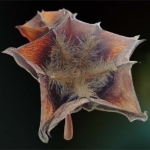2-minute read
Something unusual happened in New York City last week—the skyline disappeared. Plumes of smoke emanating from the hundreds of wildfires blazing across Canada’s boreal forest descended over the Eastern seaboard, and in just a few hours, Manhattan’s skyscrapers faded out, obscured by an eerie orange haze. As visibility plummeted, so did air quality, topping out at a hazardous to everyone 352 on the U.S. Air Quality Index (AQI). The particle pollution generated from wildfires that made it hard to see also made it difficult and dangerous to breathe.
While the air quality in NYC and other East Coast urban areas returned to a healthier range this week, city residents learned firsthand that you don’t have to be a forest inhabitant to experience the life-disrupting impacts of extreme wildfires. As the planet heats up and the number and intensity of wildfires continue to increase, scientists are exploring options to remove particulate matter and other pollutants from the air in high-population areas. One nature-based solution that both cleans and cools the air in cities and improves overall health and well-being: more green space.
If Orange is the New Blue, is Green the New Black?
Environmental scientists have concluded that planting trees is one of the most effective ways to remove heat-trapping CO2 from the atmosphere. New research has shown that leafy green sky vacuums are also absolute champs at filtering particle pollution that accumulates in high-density urban areas and is hazardous to human health. Researchers studying the absorption capacity of diverse types of trees found that while many species are effective air purifiers, one type, in particular, is good at absorbing particulates—pines.
Studies comparing the needles of evergreen pine trees to the leaves of seasonally shedding trees, including birch, poplar, beech, and ash trees, show that pine needles have the greatest year-round and longer-term potential to absorb particulate matter pollution. Air quality models created by scientists at the University of Graz factoring in leaf shape, texture, and wind patterns found that one square kilometer of pine forest planted throughout a city of 300,000 reduced the number of days that particle pollution registered over the healthy limit from 54 to 25. Increasing overall pine-age helped dial back the dust by almost fifty percent.
Trees Absorb Pollutants So You Don’t Have To
Although environmental researchers may not yet be able to provide an exact urban tree-planting protocol to help turn orange skies blue again in the case of extreme wildfire events, under relatively normal conditions, designating more green space in urban areas and planting tree species that absorb particulate pollution can help city dwellers breathe a whole lot easier.
Increasing the capacity of forest ecosystems to function as nature intended by reducing heat-trapping emissions that contribute to the drought conditions that intensify wildfires should be a top priority. As residents of New York, Boston, Philadelphia, and Washington D.C. learned last week, on a rapidly warming planet, what happens in the forest doesn’t stay in the forest—even if the forest is one thousand miles away.

ICYMI Nature News
The Tallest Sky Vacuum Ever—Ever
After a multi-year quest in search of the tallest tree in the Amazon rainforest, intrepid trekkers have finally captured exclusive drone footage of the ancient giant—in a grove of giants. Follow along on their journey here.
Roadtripping Wildlife
When humans stayed in, animals stepped out. Scientists studying the impact of Covid-19 lockdowns on the movement patterns of wildlife have discovered that curious critters took advantage of low-traffic highways and byways to get around. Learn how they made use of the roaming room here.
Hornless Rhinos Are Homebodies
Removing rhino horns to help protect the critically endangered species from poachers is turning the animals into apprehensive homebodies. Without an intact horn to protect themselves and their territory, scientists believe the modified rhinos are playing it safe by reducing their range. No horn, no go, no way.
Meet the Carpenter Squirrels
Flying squirrels in China gnaw grooves in nuts to wedge them in trees, keeping them high and dry and ready for snacking. Crafty!
A Turtle’s Eye View of the Great Barrier Reef
If you’ve ever wondered what sea turtles get up to underwater, scientists at the World Wildlife Fund have captured some amazing turtle cam footage so you can see what the reptiles see—in the sea. Have a look!
What’s the Big, Beautiful Picture?
The winners and finalists of the 2023 Natural World Photography Contest have been announced, and you can explore the amazing images of the world’s wonders here.
FWP Carbon Capture Report
Trees for cooling, trees for purifying the air, trees for habitat, trees for income. We plant them all over the world with the help of our tree-planting partners at Tree-Nation. From April 2022 through May 2023 the trees we’ve planted across 12 projects bring our carbon capture total to 3,787 tons of CO2. That’s equivalent to 371,990 gallons of diesel consumed, 4,241,864 pounds of coal burned, or 460,643,616 smartphones charged.































































